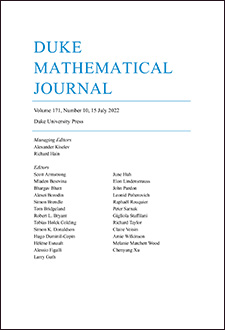Abstract
Let traverse a sequence of cuspidal automorphic representations of with large prime level, unramified central character, and bounded infinity type. For , let denote the assertion that subconvexity holds for -twists of the adjoint -function of , with polynomial dependence upon the conductor of the twist. We show that implies .
In geometric terms, corresponds roughly to an instance of arithmetic quantum unique ergodicity with a power savings in the error term, , to the special case in which the relevant sequence of measures is tested against an Eisenstein series.
Citation
Paul D. Nelson. "Subconvex equidistribution of cusp forms: Reduction to Eisenstein observables." Duke Math. J. 168 (9) 1665 - 1722, 15 June 2019. https://doi.org/10.1215/00127094-2019-0005
Information





